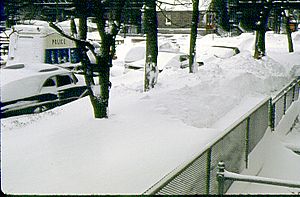1967 Chicago blizzard facts for kids
| Category 5 "Extreme" (RSI: 18.13) | |

Sidewalks filled with snow
|
|
| Type | Blizzard with thunderstorms |
|---|---|
| Formed | January 26, 1967 |
| Duration | 29 hours |
| Dissipated | January 27, 1967 |
| Lowest pressure | 997 mb (29.44 inHg) |
| Lowest temperature | 15 to 20 °F (−9.44 to −6.67 °C) January 26–27, 1967 |
| Tornadoes confirmed | Funnel clouds sighted |
| Highest winds |
|
| Maximum snowfall or ice accretion | 23 inches (58 cm) |
| Damage | $150 million (1967 dollars); all transportation stopped |
| Areas affected | Northeastern Illinois and Northwestern Indiana |
The Chicago Blizzard of 1967 was a huge snowstorm that hit parts of Illinois and Indiana. It happened on January 26–27, 1967. Chicago and its nearby towns got a record-breaking 23 inches (58 cm) of snow. This storm was a big surprise and stopped the city for several days. People had to work hard to dig out from under the snow.
Contents
What Made the 1967 Blizzard So Strong?
A blizzard is more than just a lot of snow. It also has very strong winds. The Chicago Blizzard of 1967 had winds over 50 miles per hour (80 km/h). These strong winds blew the snow around, creating huge snowdrifts. Some drifts were as tall as 15 feet (4.6 m)! This made it very hard to see or move around.
Record Snowfall for Chicago
The 23 inches (58 cm) of snow that fell was the most Chicago had ever seen from one storm. As of 2017, it still holds the record for the biggest snowfall in the city's history. The snow fell quickly, covering everything in a thick white blanket.
A City Comes to a Halt
The blizzard started during the day when many people were at work or school. Because it was so sudden and severe, it caught everyone off guard. Cars got stuck in the snow, and buses and trains stopped running. This meant many people couldn't get home. The city became very quiet as all transportation stopped.
Life During the Blizzard
For several days, Chicago was almost completely shut down. Schools closed, and businesses couldn't open. People had to stay home because the roads were impassable. It was a challenging time for everyone. Families had to find ways to keep warm and entertained indoors.
Digging Out After the Storm
Once the snow stopped, the hard work began. People had to dig out their cars and clear their sidewalks. Snowplows worked tirelessly to clear the main roads. It took many days to get the city moving again. The huge snowdrifts made the cleanup even harder.
Impact on People and the City
Sadly, the blizzard caused some serious problems. Many people were affected, and some even lost their lives. The storm also caused a lot of damage, costing about $150 million in 1967 money. This money was needed to fix things and clean up the city. The blizzard showed how powerful nature can be.
Images for kids





